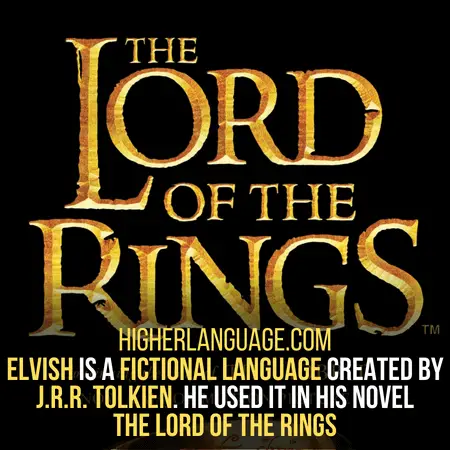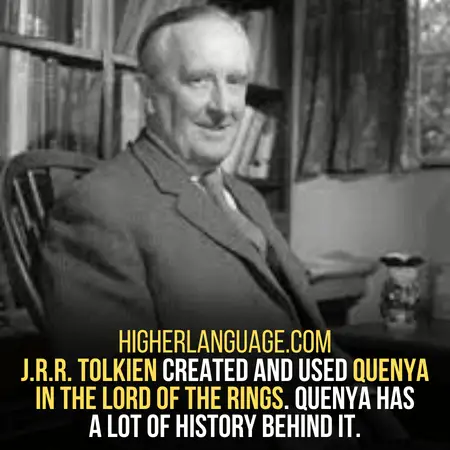If you are a linguist, then you probably know that there are dozens of real-life languages. But what about fictional languages?
[toc]
Languages are fun, and so are fictional languages! Fictional languages have been featured in literature, television, and film.
11 Fascinating Fictional Languages
This article will explore some of the most common fictional languages. Let’s take a look at some of them!
A fictional language is a language created by an author, but it’s not intended to be used in everyday life.
In some cases, the language is specific to a book or characters. In others, it can be used for any purpose and by anyone who speaks that fictional language.
A good example of this would be Esperanto. It is a constructed international auxiliary language devised by L.L. Zamenhof (1859-1917).
Authors like Ursula K. Le Guin and other creative writers from around the world used this language as a teaching tool!
1. Elvish – Fictional Language Of The Lord Of The Rings:
Elvish is a fictional language created by J.R.R. Tolkien. He used it in his Middle-earth novels, including The Lord of the Rings and The Hobbit.
The Elves of Middle-earth used to speak Elvish. They were immortal beings with strong feelings for nature. But, they could not move or fly without wings like birds or butterflies.

Tolkien’s Elvish languages were based on several real-world languages like Old English and Finnish.
He wrote extensively about his fictional world. It includes his writings on linguistics, literature, history, and mythology.
2. Klingon – Star Trek:
Klingon is a constructed language created by Marc Okrand for the Star Trek franchise.
The language was first heard on the television series Star Trek: The Next Generation. Later it appeared in movies, books, comic books, and related media.
Klingon has been used by a race of extraterrestrial humanoids in the Star Trek universe.
It was not included in any episodes or films until 1992‘s Star Trek VI: The Undiscovered Country. Later, Leonard Nimoy reprised his role as Spock.
The word “Klingon” comes from Klingon gagh, which means “blood”. Words in Klingon are spelled out phonetically with periodic stress patterns.
This makes up for some of the relative lack of inflectional endings for verbs like “to be”.
This also makes it harder to remember words than in other languages such as French or Spanish. This is due to having no spaces between them (which can be helpful when reading aloud).
3. Dothraki – Fictional Language of Game Of Thrones:
Dothraki is a constructed language created by David J. Peterson. It’s spoken by the nomadic warriors of the Dothraki people in George R. R. Martin’s Game of Thrones books and TV series.

It has a unique sound to it that makes it stand out from other fictional languages—and also makes it easy to learn!
The alphabet of Dothraki consists of basic consonants, vowels, and syllabic consonants.
4. Sindarin:
Sindarin is a fictional language from J. R. R. Tolkien’s Middle-earth universe.
It was the language of the Sindar, those Teleri who refused to cross the Misty Mountains. They got separated from their other Teleri by the Great March (and later called Nandor).
The word “Sindarin” means “Grey Elvish”. It refers to its appearance in contrast to Quenya (Green) and Kinyaraic (Blue).
Quenya and Kinyaraic are more common Elvish languages spoken elsewhere in Middle-earth.
Sindarin was the most widely spoken language in Middle-earth during the Third Age. It’s when Dúnedain and their allies used to speak it.
The Silmarillion describes Sindarin as “the Noble Tongue”. It’s a reference to one of its many names (“Eldarin” or “Elvenling”). However, it is not always referred to as such in-universe.
5. Na’vi – Fictional Language of Avatar:
Na’vi is a constructed language spoken by the Na’vi in the movie Avatar. The character Neytiri is one of them. The word “Na’vi” means “I am”.
The word “Avatar” comes from the Sanskrit avatara, which means descent or incarnation.
Paul Frommer created Na’vi. He was a linguist at the University of Southern California. He spent four years developing the language. He had previously worked on the Star Trek franchise.

He has said that Na’vi is meant to be a “naturalistic” language—one that might plausibly develop over time in the universe of Pandora.
6. High Valyrian:
High Valyrian is the language of House Targaryen. House Targaryen was the family that once ruled Westeros and later Essos.
In Game of Thrones, it’s spoken by the characters who lived during or before Robert’s Rebellion.
The High Valyrian sound system includes:
– Five vowels: a, e, i, o, and u;
– Seven consonants: c /k/, g /g/, h /h/ (not used in formal speech), j /dʒ/, l /j/ (not used in formal speech), m /m/ [ɱ], n [ɲ] and r /r/.
7. Atlantean – Fictional Language Of The Lost Empire:
Atlantean is a fictional language spoken by the Atlanteans in the film Atlantis: The Lost Empire. Screenwriters Robert Ligeti and David Kuhlman created this language.
They based it on their understanding of ancient Greek as well as other languages.
The linguist Michael Dummett has noted that Atlantean’s sound system appears to be more consistent with vowel harmony. It’s not the same for many other languages.

This is easy to understand as its structure resembles both Latin and Ancient Greek. It doesn’t happen in most other known constructed languages).
8. Newspeak:
Another of the most important constructed languages is newspeak. It’s the creation of a renowned writer of the 20th century, George Orwell. Despite not being a linguist, he was an influential writer.
Newspeak is the fictional language used by the party to control thought. The purpose of Newspeak was to eliminate all words that were “thought-crime.” It eliminated any speech or writing that contradicted the Party’s policies.
The goal was to make it impossible for a person who wasn’t part of the Party to understand what you were saying.
Its purpose was also to make it impossible for you to think thoughts contrary to their wishes. The official dictionary of Newspeak contains only one word, meaning “good”. All other words are compounds.
For example,
– Three-pint (three parts)
– Doubleplusungood (two times worse than useless)
– SixtyMinuteSpeechHour (a minute speech hour).
There are many grammatical rules to govern the construction of certain word combinations.
For example, if you say “I think”, then you must use an apostrophe after your first letter (“‘Thinks’).
9. Esperanto:
Esperanto is a constructed language. Ludwik Lejzer Zamenhof created this language in the late 19th century.
It aims to be easy to learn so that it can be a lingua franca. More than five million people across the world speak Esperanto.
The language’s name derives from a pseudonym Zamenhof adopted to protect his family. Esperanto means “one who hopes” in that language.
Esperanto has been the most popular constructed language in the world. Ido and Interlingua come after Esperanto in popularity.
10. Quenya – Fictional Language Of Lord Of The Rings:
J.R.R. Tolkien created and used Quenya in The Lord of the Rings. It’s a fictional language, but there are plenty of reasons why you might want to learn it!
Quenya has a lot of history behind it. It plays an important role in many parts of the Middle-earth legendarium. Its creators wanted it to be similar to Latin or Greek, but with some differences.
These differences would make it stand out as its own thing. They also give an airy feel when spoken aloud by elves (or other beings).

The language uses many ancient elements like roots from Old English. It includes Latin words mixed with new ones made up by Tolkien himself based on Irish mythology.
This gives Quenya its unique soundscape. It sounds very different from English but still retains some familiar words such as “dún” (“fortress”) or “tárië” (“tower”).
11. Talossan:
Talossan is a constructed language designed by Marc Okrand. He created it for the micronation of Talossa.
People of Talossa, who live in an area called “Talon” speak this language. The language’s name derives from its creator’s last name (Okrand).
Talossan is to other Romance languages like French and Spanish. But it has some differences.
For example, there are no articles in it (like English). Pronouns come before nouns instead of after them. Verbs are usually split into two parts (e.g., “to talk” → “talk”).
There is only one written form of Talossan used today. It is a modified version created by Dr. Edith Chastellain in 1938.
However, most speakers use only spoken forms when communicating with each other verbally.
Conclusion
In conclusion, fiction is a great way for us to escape from the harsh realities of our day-to-day lives.
It allows us to take on a new identity and explore other worlds through books, movies, and more.
If you’re looking for a new language to learn, or just want some fun when watching TV shows, then we’ve got some good news.
There are many fictional languages in existence that you can learn and even use in everyday life!
These fictional languages are very fascinating. They offer us a glimpse at what something might look like if it were real.
They also allow us to get a better understanding of ourselves as human beings.
We can do it by exploring different cultures or locations in an unfamiliar setting. They include new characters who speak different languages than we do every day!